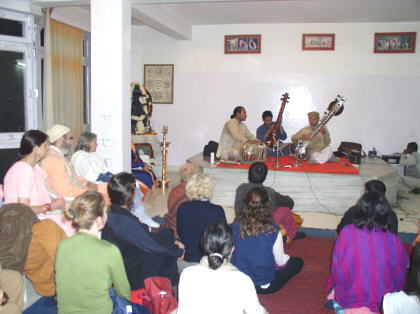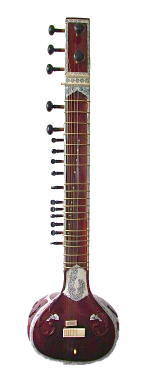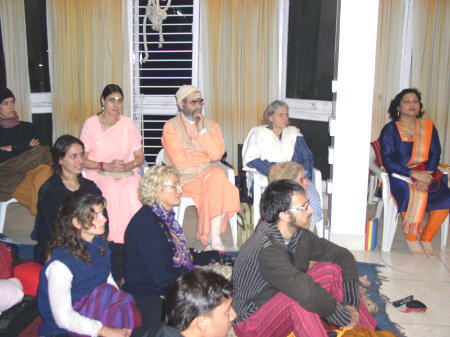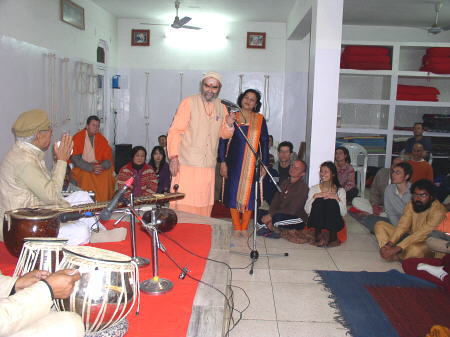 |
 |
|
A musical evening was
organized on the 3rd Day of the Mahotsava at Omkarananda Ganga
Sadan under special supervision of Usha Deviji, in which a
Sitar-Concert was presented by Sri Jagat Adhikary, who is a
direct disciple of world famous Sitar Maestro Pt. Ravi Shankar.
|
The programme was inaugurated by Sri Vinod
Barthwal with the lighting of the lamp. The evening was unveiled with a
speech on Indian Classical Music delivered by Miss Sangeeta Adhikary,
Head of Department, Computer Science, Omkarananda Saraswati Nilayam,
Rishikesh. Some excerpts from that speech:
'My heartfelt salutations to
H.H. Swami Vishveshwaranandaji Maharaj, Respected Narasimhuluji,
Somashekhariji, Usha Mataji, and other Swamijis who have blessed us
with there benign presence here, today.
'Good evening ladies and
gentlemen! It's my privilege to welcome you all to this auspicious
day when we, the entire Omkarananda family are celebrating the
Mahotsava of our Great Gurudev Paramahamsa Swami Omkaranandaji
Maharaj.
'Indian Classical Music took
its origin from the concept of Nada Brahma, which means that the
whole universe was created from the energy of sound, it's only the
sound that exists in the beginning. The music of India is one of the
oldest unbroken musical traditions in the world, because it is said
that it has come from SAMAVEDA (one of the four ancient scripts of
the Hindus).
'This form of music went
further exploring the mysteries of nature with immense spiritual
interpretations. This great knowledge was carried forward by
GHARANAS or traditions for thousands of years. One of the very
ancient traditions of receiving knowledge from the teacher in India
is known as Guru - Shishya Parampara. This teacher-student tradition
established a method, which is being passed down through
generations, with equal devotion from the teacher and to the
student. Today we are very fortunate indeed to have Mr. Jagat
Adhikary as one of such disciples, who have received his music
training in this tradition, an unique but very effective tradition
of GURU SHISHYA PARAMPARA from world renowned Sitar Maestro Pandit
Ravi Shankar''
|

A spell-bound audience listening to the
Sitar-concert
of Shri Jagat Adhikary |
A brief life sketch of the day's artist, the
well known Sitar Maestro Sri Jagat Adhikary, was also presented:
''Born in Krishnanagar near
Calcutta (now Kolkata), West Bengal, Maestro Adhikary has been
brought up in a Spiritually High and Musical atmosphere. Initially
he had taken training from his father and later on started taking
music lessons from a very renowned Sitar exponent, Late Pt. Jitendra
Mohan Sengupta, - a disciple of Ustad Enayet Khan of Miya Tansen
Gharana, (the legendary Saint musician of 16th Century).
'On the advice of Ustad
Allauddin Khan (Popularly known as BABA) and Guru of Pandit Ravi
Shankar, in 1950, he went to Delhi to meet Pt. Ravi Shankar. After
observing his performance Pandit Ravi Shankar accepted him as one of
his 'Shishya' (disciple) and started giving him thorough training in
Guru-Shishya Parampara.
'Maestro Adhikary has
exhibited his expertise in various public performances, such as in
'Allauddin Conference' in 1968 at Calcutta and other Classical
conferences at Delhi, Nepal, Allahabad, Varanasi, Lucknow etc.
'He is a founder-director
of a music cultural organization named 'SANGEETA' at Lucknow.
Maestro Adhikary proved his authenticity towards the direction also.
In 1970 he was felicitated by the then Governor of Uttar Pradesh for
his extraordinary performance as director and music composer for a
Ballet named 'Sangeet Utpatti' (the Evolution of music). He had
started a music Academy named 'Sangeet Kala Kshetra' at Lucknow in
late 70's too.
'In the year 2003 he was
invited and honoured by the Governor of Uttaranchal, His Excellency
Sri Surjeet Singh Barnala, for his outstanding service to Indian
Classical Music.
'The Director General of ALL
INDIA RADIO, 'PRASAAR BHARTI' (Dept. of Broadcasting Corporation of
India) appointed him as member of Classical Music Audition Board of
ALL India Radio (A.I.R.).
'Nowadays Maestro Adhikary
is living in Rishikesh with his family and working restlessly to
spread out the power of Spiritual and Pure music throughout the
world by giving advanced training in the field of classical music to
the students, those who come from different parts of the world''
The speech was followed by the Sitar concert of
Sri Jagat Adhikary. He had started his concert with aalap, jhor and
jhala in Raga Kausik Kanara and continued his concert with gat in Rag
Jog fixed in Teen Taal i.e. 16 beats, followed by Ek Taal i.e. in 12
beats. A very difficult, but extremely beautiful and exciting part of
Shri Jagat Adhikary's performance was 'Sawaal-Jawaab' - a 'Question and
Answer' play, in which Adhikaryji and the Tabla-Master performed
rhythmic skills on their instruments as a sort of musical 'challenge'.
This really thrilling part of the performance earned a lot of
spontaneous applause from the audience. Shri Adhikary then concluded his
concert with a composition based on mixed Raga, in which the
knowledgeable listeners could get the flavour of some devotional songs
also. He was accompanied on Tabla by Mr. Shivananda Sharma, a worthy
disciple of Ustad Ilmas Hussain Khan of Lucknow Gharana, and
Shivanandaji's younger brother on the Tambura.
|

Vote of Thanks by Swami Vishveshwarananda |
The evening had come to an end with the Vote of
Thanks by H.H. Swami Vishveshwaranandaji Maharaj. He honoured the guest
artists and appreciated them with his heartfelt verses. He could inspire
everyone with his worthy influential words and explained the magical
impact of music on all living beings. A large number of music lovers and
eminent guests of the city witnessed and enjoyed that beautiful evening.
|
The Indian
Music: Its Differentia
Apart from
its aesthetic and artistic value, this wonderful art of music
had always held for the Indian mind, a clarion call to spiritual
development, and had been widely cultivated and had attained a
high level of perfection in India... It was never regarded in
India as a mere lay art, as a mere system of pleasing the
sensuous part of man. It was always held to be but an extension
and outward symbolisation of the Omnipresent Pranava Sound - OM
- and utilised only for purposes of God attainment...
- Swami
Omkarananda - |
|